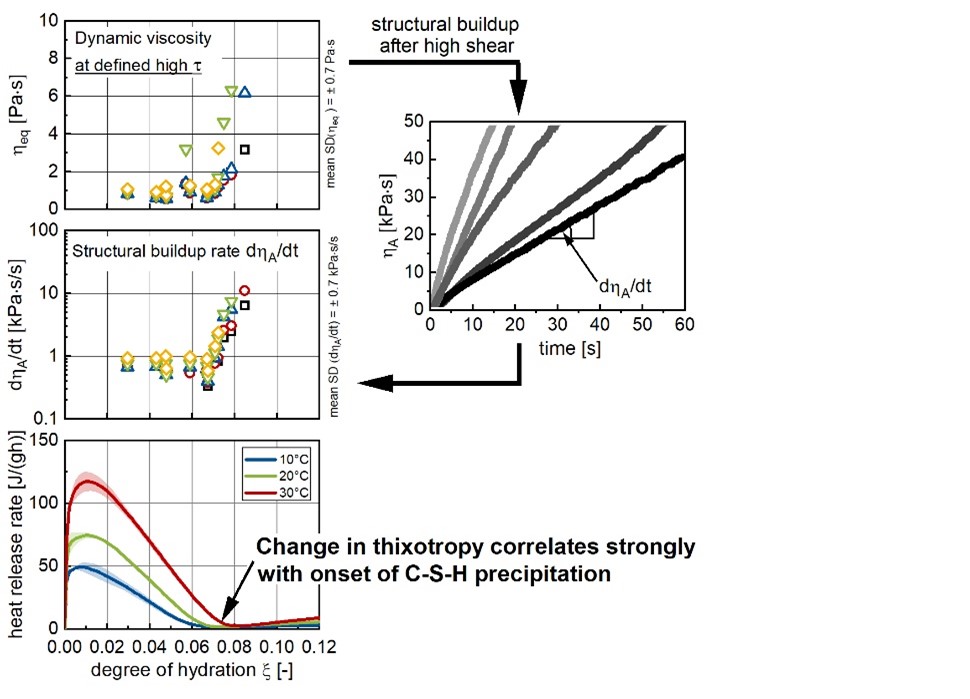7. Component additive approach to predict cement paste rheology considering mineral and particle heterogeneity on different scales (CONCERT)
Principal investigator(s) – PI
- Prof. Dr.-Ing. Michael Haist
Leibniz Universität Hannover, Institut für Baustoffe - Prof. Dr.-Ing. Horst-Michael Ludwig
Bauhaus-Universität Weimar, Finger-Institut für Baustoffkunde - Prof. Dr. habil. Thorsten Schäfer
Friedrich Schiller Universität Jena, Institut für Geowissenschaften, Lehrstuhl für Angewandte Geologie
Researcher(s) in-charge – RI
- Dr. Teba Gil-Diaz
Friedrich Schiller Universität Jena, Institut für Geowissenschaften, Lehrstuhl für Angewandte Geologie - Dr.-Ing. Thomas Sowoidnich
Bauhaus-Universität Weimar, Finger-Institut für Baustoffkunde - M.Sc. Julian Link
Leibniz Universität Hannover, Institut für Baustoffe
Associated researcher – AR
- Dr. Frank Heberling
Karlsruhe Institute of Technology (KIT), Institute for Nuclear Waste Diposal - Dr. Johannes Luetzenkirchen
Karlsruhe Institute of Technology (KIT), Institute for Nuclear Waste Diposal - Dr. Daniel Jara Heredia
Friedrich-Schiller-Universität Jena, Institut für Geowissenschaften
Subject Area
Construction Material Sciences, Chemistry, Building Physics
Term
2018-2021
Project identifier
Deutsche Forschungsgemeinschaft (DFG) – Projekt number 387096404
Project Description
The rheological properties of fresh concrete are mainly determined by the properties of the cement paste contained therein, which generally exhibits pronounced non-Newtonian flow behaviour characterized by a yield stress and pronounced thixotropy. The rheological properties are strongly influenced by the hydration of the cement, by the system temperature and by shearing processes (resulting from e.g. material flow or vibration applied by compaction). All factors lead to a variation in the particle inventory and the carrier fluid composition, whereby the fundamental mechanisms are not yet fully understood. The objective of the requested project is to establish the predictability of the rheological properties of superplasticized cement paste on the basis of the influencing parameters mentioned and as a function of the materials used (i.e. cement, water and superplasticizer). For this, surface complexation models are to be derived by means of AFM-measurements of the constituent minerals of the cement and its hydration products considering the action of superplasticizers. Using the so-called component approach, these then allow statistically firm determinations of the interaction of particles consisting out of arbitrary fractions of these minerals. By conducting measurements with variation in particle size and surface roughness, the effect of granulometry is considered. Changes in phase inventory and granulometry of the system are captured by extensive chemical and physical investigations and subsequently modelled. Through the use of radio-tracers, determinations can be made regarding the adsorption behaviour of superplasticizers to the surface of cement particles or rather the integration of superplasticizer within the hydration products. The results obtained from these investigations will be combined with extensive measurements of the cement paste rheology. These rheological properties will be measured both at atmospheric and elevated isotropic pressure, as well as applying additional vibration and temperature. By combination of in-situ and ex-situ measurements, changes within the particle and solution inventory as a result of shear can then be used, in combination with the aforementioned component approach, to develop a prediction model for rheological properties. The intended model approach is characterized by two characteristics: It distinguishes between the contribution of the colloidal and non-colloidal inventory towards the rheology and allows thereby a distinctly improved definition of the effects such as temperature and hydration upon the decisive particle inventory (meaning the colloidal components). Furthermore, the model will be probabilistically formulated and account for both the heterogeneity of the cement stemming from the mineral phase composition, as well as resulting from agglomeration or shear banding. The PP-proposal at hand has been closely coordinated with other PP-submitters.

Publications
Data in Brief 27 (2019)
Materials and Structures 53 (2020)
Cement and Concrete Research 130 (2020)
Materials 13 (8) (2020)
